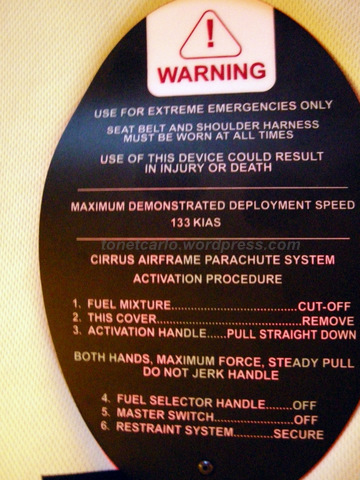I like my chances better with my 11-year-old son following ground instruction than the chances with the 'chute. Assuming the airplane has fuel, is VFR, and flying well - all realistic assumptions in my case.
Here is some food for thought (and contrast it with the 80-year-old woman that was talked down recently in Cessna 414):
To Pull or Not to Pull
Similar to a Cirrus, the rate of descent of a Skylane without power, flaps up is about 800 feet per minute. According to BRS, the parachute manufacturer, and NTSB findings, the Cirrus rate of descent beneath a parachute is at least double, between 1,600 and 1,800 feet per minute.
Engine-out Descent Rate
Cirrus Under Parachute 1,600 fpm Uncontrolled
Cessna Glide 800 fpm Controllable
Incidentally, when Cessna designed the fowler-type flaps for the Skyhawk, they were called "Paralift" flaps. "Paralift" flaps substantially lower the stalling speed (to more than 20 knots less than that of a Cirrus). They also provide a gentler landing.
So, what if the pilot becomes incapacitated? Then what?
In a Cirrus, the passenger must shut off power to the engine, and follow the instructions on the emergency placard to activate the parachute. A passenger in a Cessna can also shut off power by pulling a big red knob, then turning the elevator trim wheel full up to attain best glide speed. With a Cessna, there remains an opportunity to steer the plane to avoid injury to people on the ground as much as possible.
Pulling the parachute has serious risks. The aircraft's rate of descent under the parachute is high. Ground impact forces are severe. Cirrus warns that the decision to deploy the parachute should not be made lightly because parachute deployment may result in "severe injury or death to the aircraft occupants."
The Cirrus, like every aircraft, comes with a Pilot Operating Handbook. That's the "bible" that the pilot is supposed to follow. The emergency checklist for an "engine out" scenario does not mention the parachute system:
Forced Landing (Engine Out): If all attempts to restart the engine fail and a forced landing is imminent, select a suitable field and prepare for the landing.
A suitable field should be chosen as early as possible so that maximum time will be available to plan and execute the landing. . .
The checklist then sets forth the 12-step "forced landing" checklist.
No mention of the parachute, anywhere.
In the back of the Handbook, there is a separate section on the use of the parachute. This section lays out various scenarios in which the pilot should consider deploying the parachute, such as after a mid-air collision, aircraft structural failure, or loss of aircraft control
- And finally, and yes, I know there are plenty of claimed saves for the CAP system:
http://www.dailymail.co.uk/news/art...kills-businessman-Ray-Harris-2-daughters.html
A businessman and his two teenage daughters died in a plane crash yesterday afternoon after the parachute failed to slow the craft down.
Ray Harris and girls Ramie and Shey perished, along with a man believed to be the co-pilot, after the single-engined Cirrus-SR2 plummeted into a farm field near the Chicago suburb of Crystal Lake.
It shattered into several pieces, killing all on board instantly, while on its way from Marion, Indiana to Wheaton, Illinois, where Shey, the eldest, attended college.




